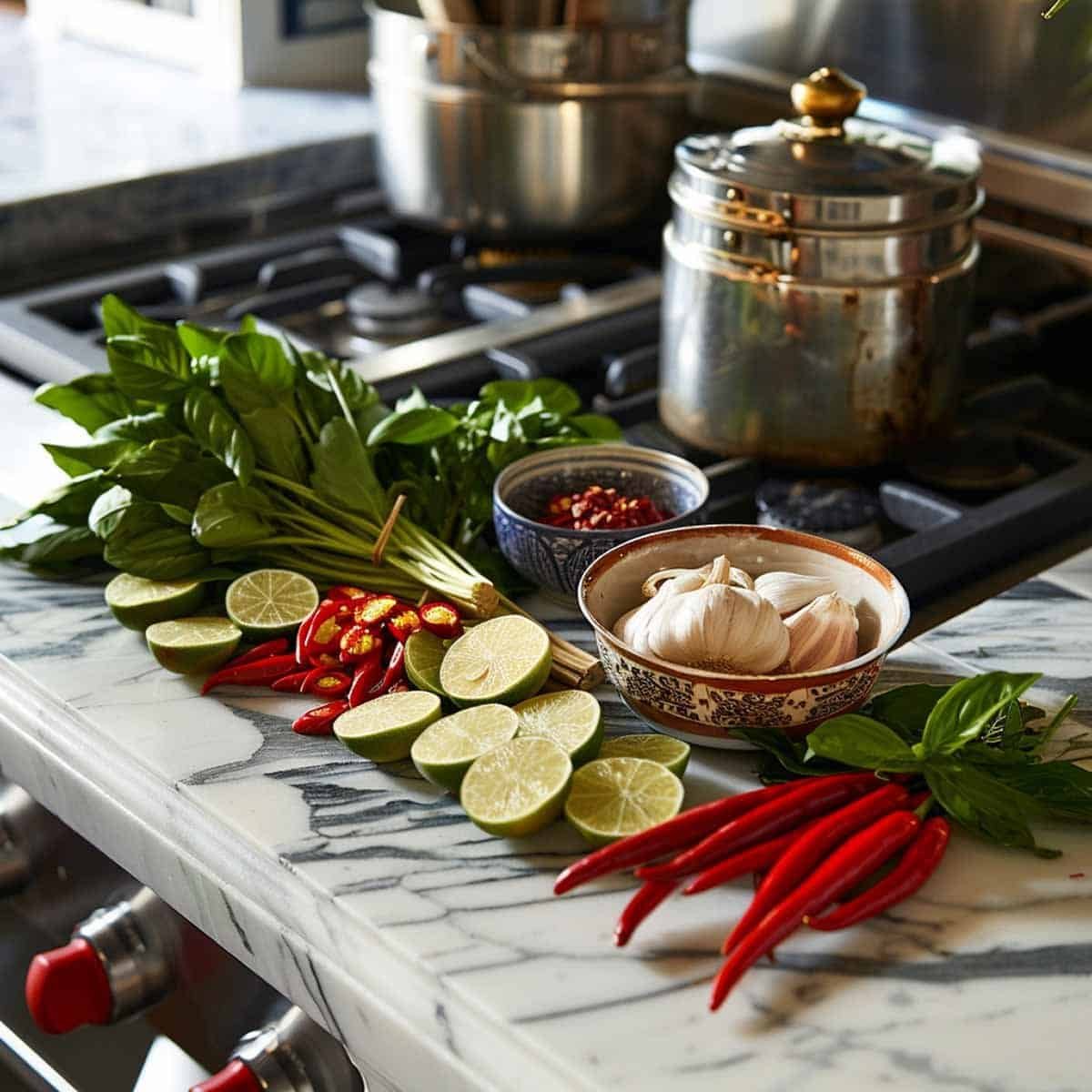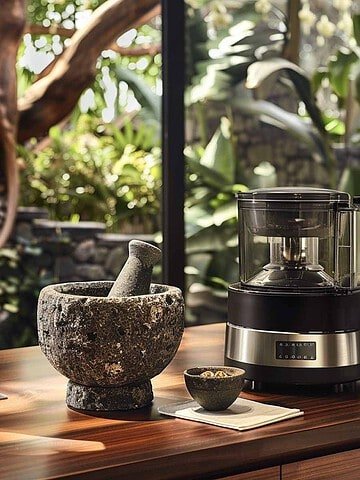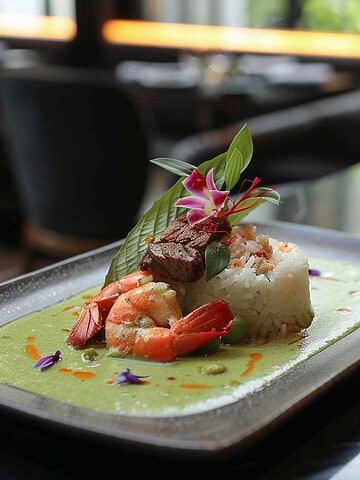
Thai cuisine, celebrated worldwide for its vibrant flavors, aromatic herbs, and harmonious balance of sweet, sour, salty, and spicy elements, is deeply rooted in the cultural diversity of Thailand. At the heart of this culinary tradition lie several key ingredients that not only define its distinctive taste profile but also offer a glimpse into the rich cultural tapestry of Thailand. In this article, we delve into the essentials: galangal, kaffir lime leaves, and fish sauce.
Thai cuisine, celebrated worldwide for its vibrant flavors, aromatic herbs, and harmonious balance of sweet, sour, salty, and spicy elements, is deeply rooted in the cultural diversity of Thailand. At the heart of this culinary tradition lie several key ingredients that not only define its distinctive taste profile but also offer a glimpse into the rich cultural tapestry of Thailand. In this article, we delve into the essentials: galangal, kaffir lime leaves, and fish sauce.
Introduction to Thai Cuisine
Thai cuisine is renowned for its diversity, from fiery curries to fragrant soups and zesty salads. At its core are fresh ingredients and bold flavors that reflect Thailand's geographical and cultural diversity. Each region of Thailand brings its unique twist to traditional dishes, often centered around locally sourced herbs, spices, and sauces.
Understanding Thai ingredients is key to mastering authentic Thai cooking. Among the myriad herbs, spices, and condiments used, galangal, kaffir lime leaves, and fish sauce stand out for their indispensable roles in both everyday meals and festive feasts.
1. Galangal: The Aromatic Root
Overview: Galangal (Alpinia galanga), a rhizome belonging to the ginger family, is a unique ingredient in Thai cuisine. Also known as Thai ginger or Siamese ginger, it has a sharper, citrusy aroma and a peppery taste that sets it apart. This distinct flavor profile makes it a must-have in Thai dishes, adding a refreshing, tangy kick.
Flavor Profile: Fresh galangal is characterized by spicy, citrusy notes reminiscent of pine and ginger. It adds a refreshing, tangy kick to dishes, making it a staple in Thai cuisine.
Uses in Thai Cooking: Galangal plays a pivotal role in Thai curry pastes, such as the fiery Tom Yum and the rich Red Curry. Its bright flavors also shine in soups like Tom Kha Gai (coconut chicken soup) and stir-fries, imparting depth and complexity.
Where to Source: Fresh galangal can be found in Asian supermarkets, often sold alongside ginger and lemongrass. It's also available dried or powdered, though fresh galangal is preferred for its vibrant flavor.
In Thai kitchens, galangal is typically sliced or pounded into pastes to release aromatic oils, infusing dishes with its distinctive essence. Its ability to cut through rich coconut milk and balance spicy chilies makes it indispensable in Thai curries.
2. Kaffir Lime Leaves: Fragrant Citrus Essence
Overview: Kaffir lime leaves (Citrus hystrix) are perhaps one of the most aromatic and recognizable ingredients in Thai cooking. These double-lobed leaves are prized for their potent fragrance and citrusy flavor.
Flavor Profile: The leaves impart a unique combination of citrusy tang and floral notes with a hint of bitterness. They are used primarily for their aromatic qualities rather than their texture.
Uses in Thai Cooking: Essential in Thai curries (e.g., Green Curry), soups (e.g., Tom Yum), salads (e.g., Larb), and stir-fries (e.g., Pad Thai), kaffir lime leaves infuse dishes with a refreshing zest. They are often torn or finely shredded before being added to dishes, releasing their oils and intensifying the flavor.
Where to Source: Fresh kaffir lime leaves are best sourced from Asian markets or specialty grocery stores. Dried leaves are a convenient alternative but may lack the same intensity as fresh leaves.
Kaffir lime leaves are not typically eaten whole due to their tough texture; instead, they are used as a flavoring agent. Their presence in Thai cuisine adds a distinctive aroma that complements spicy and savory dishes, contrasting with rich coconut-based curries.
3. Fish Sauce: The Umami Elixir
Overview: Fish sauce (nam pla), a cornerstone of Thai cuisine, is revered for its umami-rich flavor and essential role in creating a harmonious balance of sweet, sour, salty, and spicy elements. Made from fermented fish, it has a pungent aroma and a salty, savory taste that enhances dishes without overpowering them.
Flavor Profile: Made from fermented fish (usually anchovies or mackerel), fish sauce has a pungent aroma and a salty, savory taste. It's often described as having a depth of flavor that enhances dishes without overpowering them.
Uses in Thai Cooking: Fish sauce is used in marinades, dipping sauces (e.g., Nam Jim seafood dipping sauce), stir-fries, and as a seasoning in curries (e.g., Massaman Curry). It acts as a flavor enhancer, adding complexity and depth to dishes.
Where to Source: High-quality fish sauce can be found in Asian supermarkets or online retailers. Look for brands that use traditional fermentation methods for the best flavor.
In Thai cuisine, fish sauce is used sparingly but effectively to heighten flavors and create a harmonious balance. Its salty umami notes complement the spiciness of chilies, the richness of coconut milk, and the freshness of herbs, resulting in well-rounded dishes that are both savory and satisfying.
4. Other Essential Thai Ingredients
Thai cuisine boasts diverse ingredients that contribute to its bold flavors and vibrant dishes. Here are a few more essentials:
- Thai Bird's Eye Chilies: Known for their intense heat, Thai bird's eye chilies add fiery spice to dishes like Pad Krapow (Thai basil chicken) and Som Tum (green papaya salad). They can be adjusted in quantity to control the dish's spiciness.
- Thai Basil (Holy Basil): With a peppery, clove-like flavor, Thai basil is essential in dishes like Pad Krapow and Gaeng Kiew Wan (Green Curry). It adds a distinct herbal note that complements spicy ingredients.
- Palm Sugar: Made from the sap of palm trees, palm sugar has a complex sweetness with caramel undertones. It's used in desserts like Mango Sticky Rice and savory dishes to balance spicy and sour flavors.
- Shrimp Paste (Kapi): A fermented condiment made from ground shrimp, shrimp paste adds a deep umami flavor to dishes such as Kang Som (sour curry) and Nam Prik Kapi (shrimp paste chili dip).
These ingredients, along with galangal, kaffir lime leaves, and fish sauce, form the backbone of Thai cuisine, each contributing unique flavors and textures that define the culinary landscape.
5. Combining Flavors: Key Techniques in Thai Cooking
Thai cooking is as much about technique as it is about ingredients. Here are some key techniques for achieving authentic Thai flavors:
- Balancing Sweet, Sour, Spicy, and Salty: Thai dishes are known for their harmonious blend of flavors. Achieving the right balance involves adjusting ingredients like palm sugar (sweetness), lime juice (sourness), chilies (spiciness), and fish sauce (saltiness) to taste.
- Layering Flavors: Building layers of flavor enhances complexity. Start with aromatics like galangal and kaffir lime leaves, add spices and herbs, then finish with sauces and seasonings to create depth in dishes.
- Cultural Significance: Thai ingredients are deeply rooted in the country's cultural heritage, reflecting its agricultural bounty and culinary traditions. Understanding these ingredients offers insight into Thai culture and how food connects people.
6. Tips for Sourcing and Storing Thai Ingredients
To enjoy authentic Thai flavors at home, consider the following tips for sourcing and storing ingredients:
- Fresh vs. Dried: While fresh ingredients like galangal and kaffir lime leaves are preferred for their vibrant flavors, dried alternatives can be used when fresh options are unavailable. Store dried ingredients in airtight containers away from heat and moisture.
- Online Resources: Many online retailers specialize in Thai ingredients, offering convenience for those without access to local Asian markets. Look for reputable sources that prioritize freshness and quality.
- Substitutions: If certain ingredients are hard to find, consider alternatives with similar flavors. For example, ginger can substitute for galangal, and lime zest can stand in for kaffir lime leaves in a pinch.
Exploring Thai cuisine is a journey into bold flavors and aromatic herbs. By familiarizing yourself with key ingredients like galangal, kaffir lime leaves, and fish sauce, you'll unlock the secrets to creating authentic Thai dishes that delight the senses.
Conclusion
Thai ingredients such as galangal, kaffir lime leaves, and fish sauce are not just components of a recipe; they are cultural treasures that embody the essence of Thai cuisine. By understanding their flavors, uses, and sourcing options, you can elevate your culinary creations and experience the rich tapestry of Thai flavors at home.
Embrace the art of Thai cooking, where each ingredient plays a vital role in creating dishes that are as delicious as authentic. Whether preparing a classic Green Curry or experimenting with your Thai-inspired creations, let these ingredients guide you on a flavorful journey through Thailand's culinary heritage.






Leave a Reply